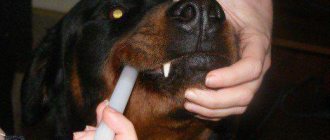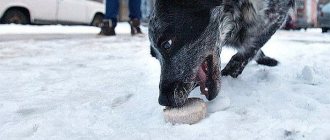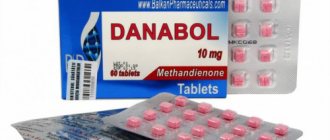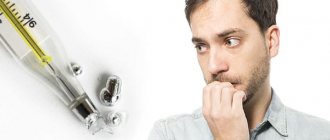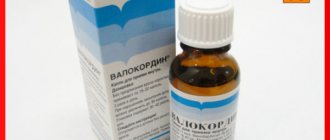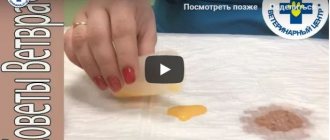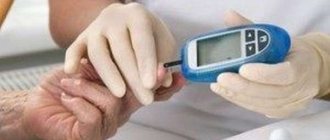On the 3rd, one might say, I was bitten by a dog (a scratch through my pants). I washed it with triple cologne (I didn’t know I needed soap). Dried blood appeared in the evening. On the 7th I went to see a traumatologist. The doctor recommended applying Levomekol and rinsing with hydrogen peroxide. A real wound has formed. Then there was a long-term treatment for an infected wound, which burned and itched badly, and still itches. At the beginning of June I turned to a dermatologist - after the doctor’s prescriptions, the wound healed, leaving a small point that scabbed but did not heal. About the dog - I saw it alive and normal for more than 80 days after the bite, then disappeared somewhere. Now I’m sick (possibly related to the bite?) with a cold - cough, low temperature, pain in the tracheas.
Symptoms
The main symptoms after a dog bite in a person are severe pain and bleeding. If timely treatment is not started, the wound may become infected. Pay attention to the following symptoms after a dog bite, which indicate the progression of the infection:
- attacks of fever;
- temperature increase;
- swollen lymph nodes;
- the appearance of pain, burning, swelling in the affected area.
The following symptoms may also occur:
- Suppuration of the wound. Without proper care and treatment, the wound begins to fester.
- Bone fractures. Large dogs, when biting, can not only break a bone, but also shatter it. This is especially true for dogs of fighting breeds.
- Damage to muscle tissue and bleeding. It can be both external and internal.
In any case, after a dog bite, you must consult a specialist to exclude infection.
When can a wound be sutured?
In accordance with the principles of rabbiology, doctors are prohibited from suturing bites during the first three days. They are also prohibited from penetrating the wound with various sharp objects. Thus, doctors do not have the right to cut off the outer tissue on the wound or make any incisions during the first seventy-two hours from the moment of the bite. This is very important, since in most cases, bites from wild animals are followed by suppuration of the wounds, and if the bite is first sutured, then suppuration occurs inside, and not from the outside. However, this principle of rabiology can be neglected in the following cases:
- When a person has an extensive wound and excessive bleeding that threatens his health;
- When a dog or other animal bite was made to the head;
- In case of heavy bleeding (in such situations, the vessels are sutured);
Types of dog bites
Before prescribing treatment for wounds after a dog bite, it is necessary to understand the types of bites. Experts define 2 types:
- Puncture wounds . The depth is much greater than the width of the damage. In this case, bleeding occurs, which only a doctor can stop. The first step is to stop the bleeding, after which the wound is treated. For this purpose, anti-inflammatory and antibacterial agents are used. A sterile bandage must be applied over it.
- Lacerated wound . This bite is more dangerous than a puncture wound. The dermis may peel off and even be partially scalped. Usually both upper and lower limbs are affected. In most cases, there is a need for sutures. Treatment continues strictly under the supervision of a specialist.
Children may be injured not only in their limbs, but also in their head and forearms. It is especially dangerous when the bite affects the head or neck area.
Causes of attacks and bites
Dog attack on a person
Unfortunately, no one is safe from a possible dog bite, regardless of its breed and upbringing. Of course, the most common cases of stray dogs attacking people are those who may be sick, angry, scared, or hungry.
A bite from any dog, even a pet, is considered dangerous to human health, regardless of whether the animal is vaccinated or how strong the owner’s immunity is. If you receive this injury, you should seek immediate medical attention.
Doctors know cases when a pet dog, which has been treated kindly by everyone, suddenly, for no apparent reason, attacks its owner and grabs him with a death grip. The behavior of some breeds is extremely difficult to predict.
Barking dog
According to statistics, large breed dogs - shepherds, boxers, Dobermans, Labradors - cause injuries during play, which is especially common in children. The highest percentage of bites is detected in young children and schoolchildren who, while playing with a dog, do not understand its behavior and continue to tease it or take away its toy.
Also, one of the factors in dog attacks on humans is the four-legged animal’s anger. This can happen due to the animal’s banal hunger, harsh treatment by others, or bullying - in this case the dog defends itself and attacks first.
The greatest threat to humanity comes from packs of stray dogs that huddle and attack in groups. Such packs of dogs must be avoided and under no circumstances should you attract their attention to yourself while walking down the street.
First aid
If the damage is not severe, and the patient is not far from home, then you should try to provide first aid for a dog bite yourself. The measures are:
- Be sure to wash the wound with any bacterial soap. You can use household items. This will help remove the dog's saliva from the injury site.
- Stop bleeding with hydrogen peroxide. Pour the product into the bite site and treat the edges with iodine.
- Place a sterile suspension on top, securing with a bandage or plaster. But it is important to apply it carefully so as not to put pressure on the wound. If the blood flow is not very strong, then you should not stop it yourself. The dog's saliva containing possible bacteria comes out along with the blood.
Often, the listed measures are enough to avoid consequences. But you still need to go to the clinic to refute signs of rabies after a dog bite.
How to treat a wound
If there is slight bleeding after a dog bite, it is enough to wash the wound area well with soap and water. When inflammation or bruising occurs, cold is applied.
If the wound is open and bleeding is coming from it, follow the first aid algorithm and use the following drugs as antiseptics:
- ethyl alcohol 70%;
- Miramistin;
- Batadin;
- hydrogen peroxide;
- Chlorhexidine.
A bandage is required. A sterile bandage, gauze pad or clean cotton cloth will do.
Signs of rabies after a dog bite
The incubation period lasts from 1 to 3 months. The rate of spread is influenced by the location of the injury. There are 3 stages of rabies considered. This:
- Initial . Duration from 1 to 3 days. Symptoms in a person from a rabid dog bite appear even if the wound heals. Patients note discomfort at the site of the bite of a domestic or stray dog, headaches, general weakness, irritability and nervousness, and an increase in temperature up to 37.5 degrees. Some patients experience vomiting, nausea, and diarrhea. Already during this period, the patient begins to have hallucinations and depression, and problems with sleep are noted.
- Excitement stage . Symptoms of rabies from a dog bite manifest themselves in the form of hydrophobia and seizures. The pulse quickens, breathing becomes difficult. The patient also develops a fear of light, open air, and loud sounds. A person experiences attacks of aggression, which manifest themselves in the fact that the person fights, scratches, and hits walls. Delusional ideas, auditory and visual hallucinations occur.
- Stage of paralysis . Outwardly, the person becomes quite calm, the functions of feelings and movement fade away. Symptoms of rabies after a dog bite are manifested in an increase in temperature to 42 degrees and a drop in blood pressure. The heartbeat quickens. The patient dies due to paralysis of the respiratory organs or heart muscle.
Only rabies injections after a dog bite can help. Therefore, under no circumstances should you hesitate, and it is important to immediately provide first aid in case of a dog bite and call an ambulance.
What not to do if bitten
- Apply a strong compressive bandage to the wound, if it is not bleeding too much (repeated reminder).
- Treat the affected area with any instrument. For example, try to apply stitches yourself or remove torn edges of the wound (dead tissue) when changing the bandage. All this is the prerogative of the medical professional, and no one else.
- Wet the treated and bandaged wound. To prevent water from getting into the bite site during everyday activities, it is advisable, in addition to being careful, to apply a waterproof material over the bandage. For example, put a plastic bag on your hand (cutting off the bottom) and fix it in this position.
Mechanism of disease development
The virus begins to quickly penetrate directly into the nerve endings through injured areas and mucous membranes. The rate of disease progression is high. Approximately 3-5 mm are affected in an hour. The disease gradually moves towards the brain.
Once the desired structures are reached, the pathogen slowly penetrates the nerve cells. There it multiplies and increases in size. Sometimes the pathogen cells return back to the center, thereby spreading throughout the body.
After this, excessive salivation occurs, sweating increases, spasm of the swallowing muscles and convulsions appear. Death occurs when vital centers are affected.
Vaccinating a person against rabies
At the slightest suspicion of a disease, a person is vaccinated after a dog bite. The injection is given in the forearm or buttock. Vaccination consists of 6 injections after a dog bite. These vaccinations can completely eliminate the virus. The vaccination schedule against dog bites looks like this:
- The first injection for a dog bite is given on the day the person is hospitalized;
- after 3 days;
- on the seventh day;
- after 2 weeks on day 14;
- one month on the 30th day after the bite;
- after 3 months on the 90th day.
Rabies vaccination is the only way to completely cure a patient. In some cases, if on the 10th day the dog is healthy and does not show any symptoms, then vaccination is stopped.
When a vaccine may not help
For a completely healthy person who has been bitten by a dog, a vaccine is a 100% cure. But there are a number of factors due to which injections may be ineffective. This:
- missed sessions;
- drinking alcohol;
- improperly stored vaccine or expired vaccine;
- late administration of the vaccine;
- long-term therapy with immunosuppressants and glucocorticoids;
- congenital weakness of the immune system.
In all other cases, vaccination will help remove the virus.
Contraindications for preventive vaccination
To prevent rabies from a dog bite, a prophylactic vaccine is needed. But there are a number of contraindications when vaccination cannot be done. This:
- carrying a baby;
- patients who are allergic to antibacterial drugs;
- persons who developed an allergy after administration of the drug;
- the presence of acute infectious diseases of a non-infectious nature.
If it is necessary to vaccinate, then conduct sessions no earlier than a month after full recovery.
Preventive vaccination
Vaccine to prevent rabies
Children often keep silent about encounters with animals for fear of being punished. To reduce the risks for the child, preventive vaccination against rabies can be performed. A similar precaution is recommended for veterinary clinic specialists, employees of laboratories and services for catching stray animals, staff of slaughterhouses and biological production facilities, and tourists traveling to countries where this disease is common.
The prophylactic course of injections against rabies is shorter than the emergency course and is easier to tolerate, which is important when it comes to young patients. The injections are given into the shoulder. After the first injection, the second (after 7 days) and third (after 4 weeks) are given. Vaccination is repeated after 2–3 years.
Treatment options
After hospitalization of the patient, the treatment method is determined depending on the type of wound, depth, and area of damage. In any case, wound treatment is important:
- Small wounds, scratches, and puncture wounds are treated with a disinfectant, after which a sterile bandage is applied on top.
- For large injuries, surgery is performed. During the operation, blockages, blood clots, and dead tissue are removed, after which the cleaned wound is treated with an antiseptic solution.
Let's take a closer look at how to treat a wound from a dog bite.
Drug therapy
First of all, drug treatment involves treating the wound with antiseptic agents. When considering what to treat after a dog bite, these are the best ways to cope with the task:
- Miramistin;
- Chlorhexidine;
- medical alcohol;
- iodine;
- brilliant green solution, etc.
For prevention and treatment, general antibacterial therapy must be used. The following antibiotics are usually prescribed for a dog bite:
- Amoxiclav;
- Lincomycin;
- Ceftriaxone;
- Augmentin;
- Ciprofloxacin and others of this type.
If the victim has a large loss of blood, then a blood substitute must be administered intravenously. In all other cases, simply inject 5% saline or glucose solution.
If the patient has purulent inflammation, then rinsing sessions are required. Dioxidin (1% solution) is indicated for this. Ointments such as:
- Levomycetin . This is a bacteriological antibiotic with a wide spectrum of effects. Disrupts protein production in microbial cells.
- Tetracycline . Broad-spectrum antibiotic. Use 3-5 times a day.
- Syntomycin emulsion . The medication is based on an antibiotic that quickly penetrates the layers of the skin and eliminates not only external factors, but also internal ones. The drug fights a large number of bacteria, coping with foci of inflammation. In addition, the product can be applied as a pain reliever.
When choosing how to treat a dog bite, do not forget to take into account the characteristics of the body and the presence of contraindications.
Surgical intervention
Primary surgical intervention consists of removing foreign objects, dead tissue and blood clots from the injured area. Afterwards, injured blood vessels and torn tissues must be sutured if the damage is serious and extensive. But external sutures are not applied to the affected tissue, as secondary infection is possible.
After cleaning and suturing the tissues, external plastic surgery is performed. A specialist installs internal drainage and secondary external sutures. Plastic surgery is only necessary in case of cosmetic defects. Most often, surgery is performed if the bite occurs on the head area.
Use of traditional medicine
Treatment of a dog bite at home using folk remedies is only possible if the wound is punctured and there are no signs of suppuration. If the wound is large enough and lacerated, and an acute inflammatory process has begun, then the surgeon will pre-treat.
It is important to understand that traditional medicine can be used as an addition to the general treatment regimen. Also, the use of folk remedies requires prior consultation with a specialist.
The most effective lotions are:
- Nettle leaves . Take young leaves, rinse well and grind into a paste using a blender. Add a little salt to the resulting mixture. Apply the prepared product to the injured area 2-3 times a day until complete healing.
- Alcohol tincture of propolis . Dilute the tincture with water in a ratio of 1 to 1. Moisten a piece of bandage or a cotton pad in the resulting solution and apply to the affected area. This remedy fights the acute inflammatory process and relieves redness.
- Salt solution . To obtain the medicine, dissolve a large spoonful of salt in 1 liter of warm water. Take a piece of gauze, soak it in the solution and apply it to the wound.
- Aloe leaves . Take a few leaves, rinse under warm water, squeeze and strain. Treat the wound with the prepared juice.
The following recipe has a wound healing effect:
- take 10-15 pcs. and pour a glass of boiling water;
- leave the product for a couple of hours, then filter;
- Take the prepared infusion 1 tablespoon 2-3 times a day before meals.
The following infusion is characterized by bactericidal properties:
- pour a small spoon of immortelle herb with a glass of boiling water;
- leave the product for an hour;
- Filter the infusion and take 1 tablespoon 3 times a day on an empty stomach.
When considering how to treat a dog bite if swelling occurs, you can use the following remedies:
- Prepare homemade healing ointment . Take plantain leaves, grind in a blender, add honey and royal jelly. All components are taken in a ratio of 1 to 1. Store the product in the refrigerator for a couple of days, after which it is applied to the injured area.
- Plantain leaves . Soak the leaves in boiling water, moisten a cotton pad in the resulting decoction, and then apply it to the sore spot.
Such products are as harmless to health as possible.
Folk remedies for treatment and their effectiveness
After being examined by a doctor and taking the necessary measures, the patient continues to treat the wound after a dog bite at home. The victims remain in the hospital with extensive injuries, rupture of muscles, tendons, arteries, and broken bones. To speed up the healing process, many resort to traditional medicine recipes. Their effectiveness has been proven for decades.
- Rinse the injury with saline solution. Method of preparation: for 1 liter of boiled warm water there is 1 tbsp. l. salt.
- Compress with aloe juice. Squeeze liquid out of the leaves of the plant, soak gauze, apply to the sore spot, change as it dries.
- Washing with propolis. Dilute the bee medicine tincture with water in a 1:1 ratio and process regularly.
- Clove infusion. Steam dried clove buds with boiling water and leave to cook for 90 minutes. Drink three times a day before meals. The product helps the skin heal faster and kills infection.
- Medicinal nettle. Grind the herb into fine powder, mix with a small amount of salt, and apply to the wound.
- Garlic therapy. Eat 5-10 cloves daily, regardless of meals. The method helps to disinfect the body and stimulate protective functions.
What to do if a dog bites a child
It is very dangerous if a dog bites a child. It is important to provide first aid and treat a dog bite in a timely manner. Do not panic, but take a number of actions:
- rinse the wound under running water with antibacterial soap;
- then apply a tight bandage to stop bleeding, if any;
- use alcohol solutions to treat the wound (70% alcohol, Miramistin, Chlorhexidine, etc.);
- apply boric ointment or Levomekol to the injured area;
- calm the child down and go to the hospital.
Only a doctor can determine whether a child needs vaccination or whether treatment can be carried out at home.
Answers from experts
Aina: Small - green, deep - levosin, levomekol, dioxykol.
Jumping bunny: treat hydrogen peroxide and take it to the vet, it’s unknown what the dog that bit yours could be sick with and NO green stuff and iodine, read the information on the Internet, call the doctor for advice and you will understand why I wrote hydrogen peroxide, although they have almost the same effect
Alenka Alenkina: yes, you need an antibiotic, but rinse with chlorhexidine
Olga: Rinse thoroughly with Chlorhexidine and apply Levomekol ointment thickly (provided you don’t need to stitch it up)
Kira Komnena: Small iodine, brilliant green. Deep - Levomikol ointment (preferably bandages), you can wash it with Chlorhexidine, hydrogen peroxide (if there is bleeding).
Katerina: Wash the wounds with chlorhexidine, bandage them if possible, and go to the vet for an antibiotic injection. Next, most likely, they will prescribe rinsing with peroxide or chlorhexidine, putting levomekol into the wounds and injecting a course of antibiotics. Can be treated with teramicin. Sometimes cavities also form, a bad thing - the skin lags behind the muscles and infection can get there. You go to the veterinarian, such wounds take a long time to heal, they need to be treated.
Lyudmila Galyuk: Go to the veterinarian if you don’t have a rabies vaccination, but you never know what kind of sore a stray dog might have? Better see a doctor. Good luck.
Nikolai Smirnov: Go to the vet immediately, there may be internal damage - let him take a look.
Oksana Nazarova: rinse with chlorhexidine
wounds can be sprinkled with streptocide powder. iodoform
Katerina Kuznetsova: Is your dog vaccinated? Now there is an unfavorable situation regarding rabies in Moscow and Moscow Region.
Natalya Chivareva: I would show the doctor, just in case, whether the mongrel is still sick...
Irima: healing wounds from dog bites is difficult, you need peace and patience. After dog bites, antibiotics are necessary to prevent infection that may occur due to bacteria transferred from the dog's teeth. Allowing blood to bleed for several minutes after the bite can help rule out bacteria. The wound must be covered for normal healing to occur. After a dog bite, the wound may become swollen or painful; in such cases, you can take painkillers. To reduce swelling, keep the affected area of your body elevated. Find out information about dog vaccinations. If the dog has received all the necessary vaccinations, you may only need an injection for tetanus, otherwise injections for rabies, etc. are also required.
This is very important for the prevention of rabies and sepsis. Along with medical treatment for dog bites, the following home remedies may be helpful to help wounds heal quickly: Apply a mixture of turmeric and honey to the wound.
The antiseptic properties of turmeric and the soothing effect of honey will help the wound heal faster. Take vitamin C daily until the wound is completely healed.
Unknown: apply baby cream...
Cranberries: Don't forget about rabies prevention. And all that remains is to wait.
VARVARA SONINA: Try to apply tar, it smells and is terrible, but all sorts of sores go away quickly
Marina Kukushkina: Apply LEVOMEKOL ointment or syntomycin!
Roman Nenashev: Synthomycin emulsion 10%, panthenol spray, a powerful antibiotic orally. In general, bites are difficult to heal.
Olga: Sea buckthorn oil is the best remedy for healing ANY wounds. )))
Viktor Melkozerov: Go to a physiotherapist, it will be great for your muscles, the rest has already been advised. And write about the future right away, that’s the people’s….
228 228:riiiiirri
DIMA: same thing
Dasha Kukushkina: can you ask me the dog bit me the wound is 2 millimeters wide and 2 cm long after school tomorrow, please tell me
What are the consequences of dog bites
The muscles that control a dog's jaw can create enormous pressure. As a result of pressure on the dermis, lacerations and puncture wounds may appear. When bitten, muscle tissue, tendons, and blood vessels are affected.
But the situation is aggravated by the entry into the body of pathogenic bacteria, which are in the mouth of every animal. Dogs' teeth are very sharp, so when wounded, all microbes penetrate deep into the wound. Humans do not have a properly developed immune system against fungi and bacteria that can be transmitted through dog saliva.
The consequence of dog bites is infection. Consider the list of bacteria that cause infection of bite wounds:
- staphylococcus;
- streptococcus;
- Proteus;
- Klebsiella;
- Eikenella;
- enterobacter;
- bacteroides;
- hemophilus;
- Neisseria;
- corynebacteria;
- porphyromonas;
- capnocytophaga;
- Moraxella etc.
The first sign of infection is inflammation of the epidermis and the release of whitish fluid. In addition, red rashes may appear around the bite. Such symptoms usually appear 8-10 hours after the injury.
The degree of danger is determined by the following factors:
- Bleeding . The stronger the blood flow, the greater the likelihood of a damaged artery. If the wounds are too deep, there is a risk of internal bleeding.
- Soft tissue injury . If the bite is superficial, then most often there are no complications. The wound quickly heals and heals with the use of wound-healing ointments and creams. In case of deeper injuries, surgery is required.
- Psychological shock . When considering why a dog bite is dangerous, it is worth considering psychological shock. When attacked, a person is put into a stupor. This leads to psychological trauma and further fear of animals. An attack can have negative consequences for people with pathologies of the heart and blood vessels. Due to the stress experienced, blood pressure increases, which leads to heart failure. In this case, urgent medical attention is needed.
Therefore, if you are bitten by any dog, you must go to the clinic, since even a pet can be infected.
What are the dangers of a dog bite to a person?
A dog bite, regardless of the size and breed of the animal, poses a danger to human health and sometimes life. For the victim, it makes no fundamental difference who bit him: whether it was a stray dog, a stranger’s dog, or a pet. The severity of the injury depends on the following factors:
- Bleeding.
- Traumatization of tissues.
- Infection.
- Mental and pain shock.
- Rabies infection.
You should stay away from a dog wedding
Bleeding
Blood loss can be life-threatening, especially if it is internal hemorrhage.
Tissue trauma
Skin, muscles, joints and bones are damaged.
Infection
A dog's mouth contains a community of microorganisms that can cause purulent inflammation. The greatest danger is the rabies virus, which is secreted by the saliva of an infected dog.
Infected wound
Mental and pain shock
An attack by an angry dog can cause not only physical but also psychological trauma. Children and people with heart disease may experience serious consequences. Painful shock is dangerous due to loss of consciousness.
How to reduce the risk of a dog attack
In order not to wonder what to do after a dog bite, you need to follow simple rules. To reduce the risk of attack:
- never run away from an approaching dog, as it will regard this as a signal to attack;
- You should not look the dog directly in the eyes, as the dog may regard this as a challenge;
- do not grab the animal by the face, tail, ears, even during games;
- do not make sudden movements or wave your arms, especially if there is a strange dog nearby;
- do not interfere in a dog fight;
- Do not leave a small child alone with animals.
If it was not possible to avoid the attack, then you do not need to immediately panic, but should carry out all the necessary manipulations.
Prevention
There are categories of people who definitely need preventive vaccinations. These are foresters, slaughterhouse workers, hunters, veterinarians, and dog catchers. In this case, do not wait to see what happens after a dog bite; it is better to immediately prevent bad consequences. First, they give an injection on the first day, after a week, a month, a year. Then just one vaccine is administered every three years. But there are also contraindications:
- Allergy (to an antibiotic or to a previous injection).
- Acute chronic diseases. It is necessary for the exacerbation to end and for the person to fully recover.
- Pregnancy.
If possible, it is best to avoid contact with unknown or known aggressive animals, especially if they are not muzzled. Not worth it:
- Tease a dog, even a chained one. He experiences strong aggression, the dog at this moment becomes stronger and can break the chain.
- Approach your pet when he is eating or guarding puppies.
- Wave your arms, run, scream loudly, show your fear or smile.
- Suddenly waking up a sleeping animal can cause it to become frightened.
- Approach him while drunk.
- Separate fighting animals.
- Approach a pack of stray dogs. They can attack for no reason, targeting a person's thighs, ankles or arms.
- Allow children to pet or leave mongrels alone.
- Respect the territory that the animal considers its own.
What can scare off an aggressive dog:
- Reciprocal anger towards her.
- A call for help, but only in a low voice, not a loud screech.
- Confident command: “No!”
- A little earth or sand thrown into the eyes.

